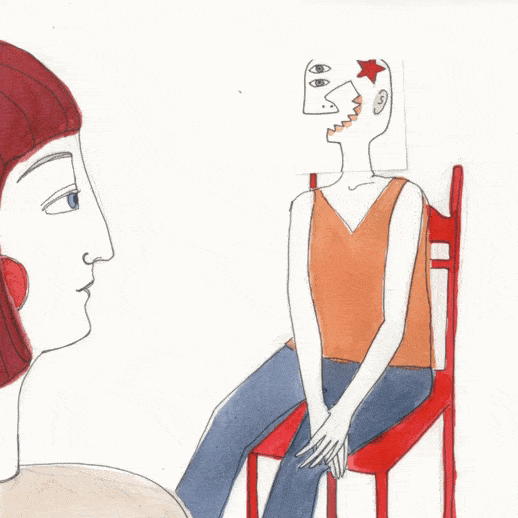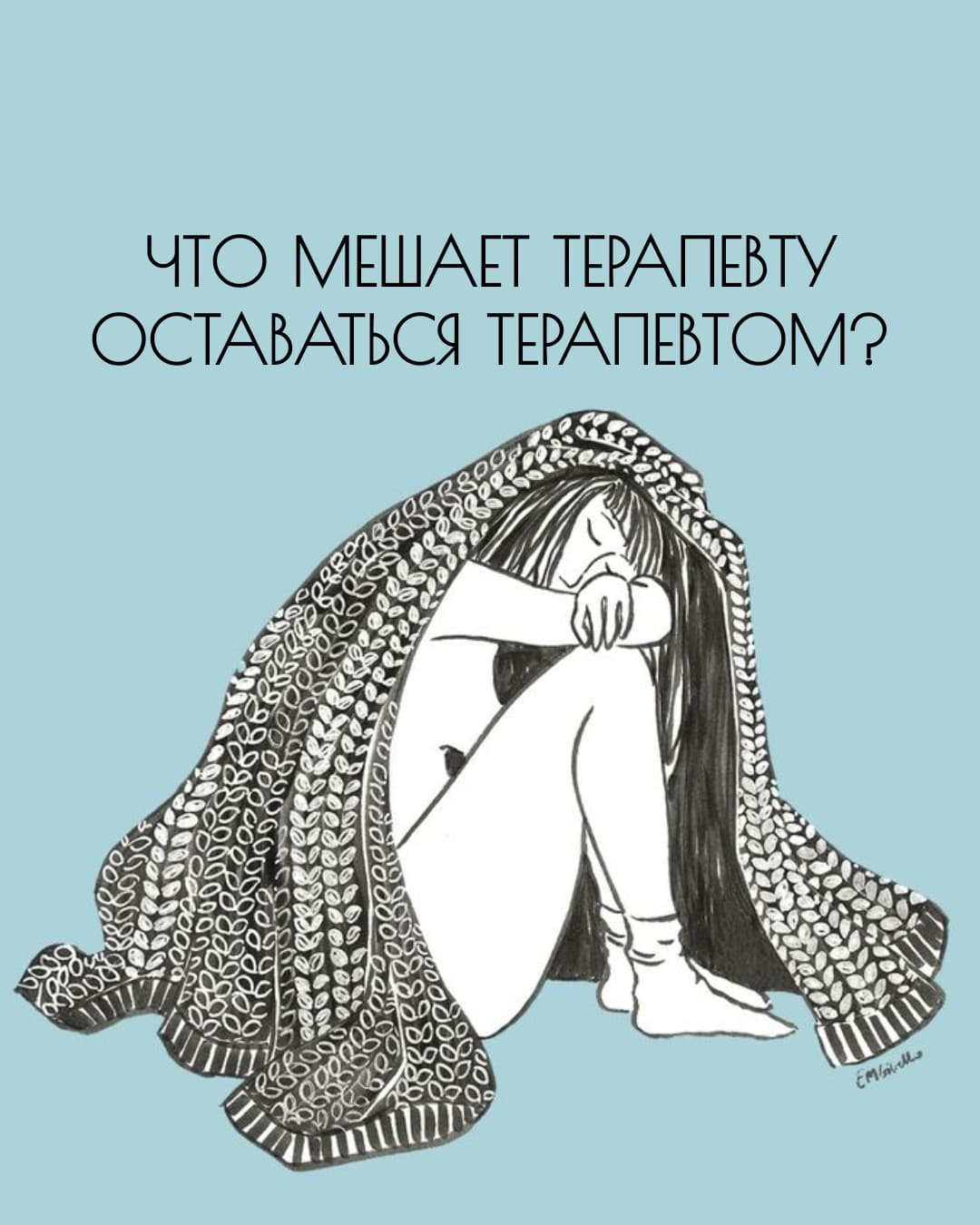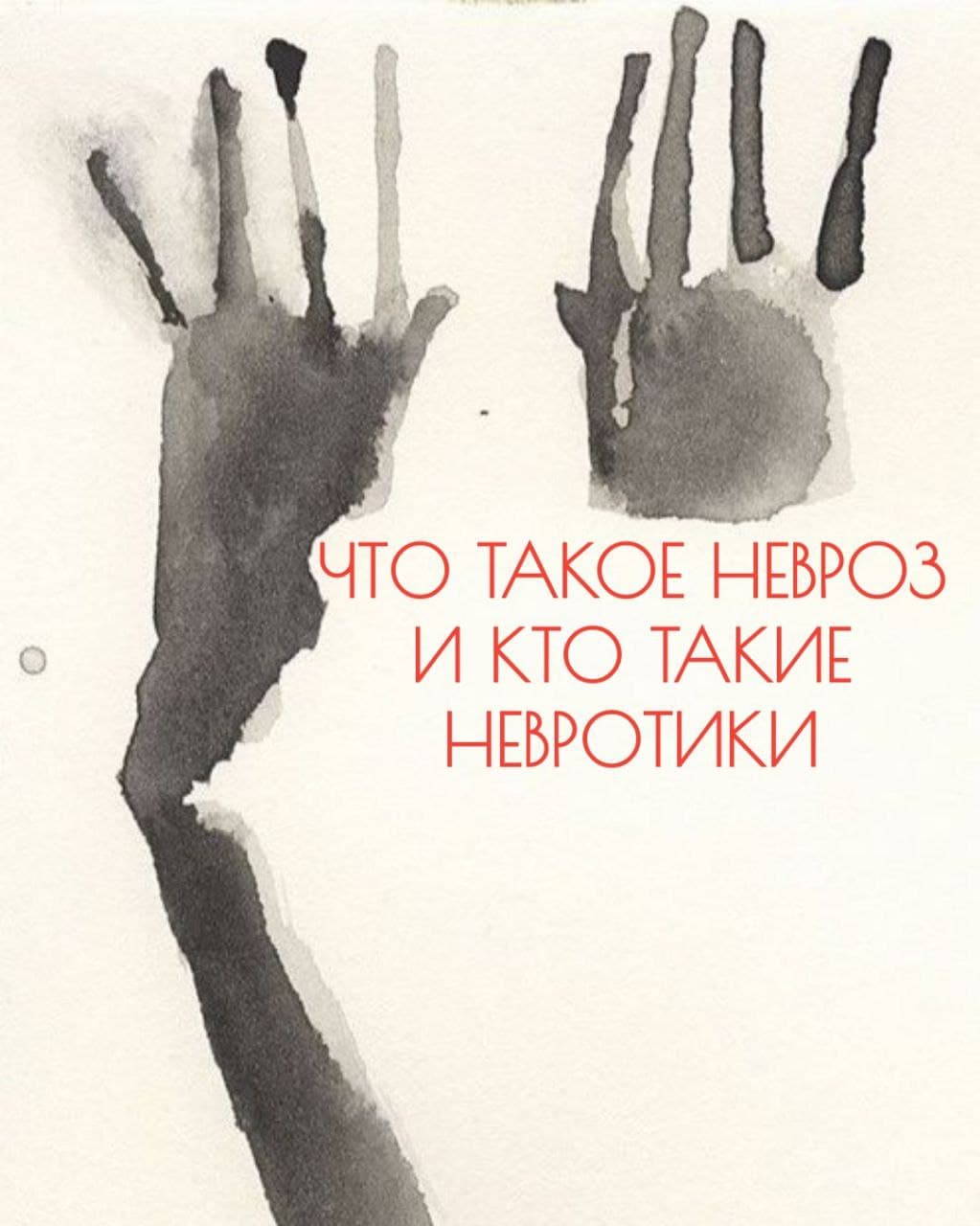
@omprograms
Uncertainty is almost inevitable and, in a way, even a familiar part of our lives. But when the level of uncertainty is high, it can affect a whole range of important aspects of our lives.

The reflections I want to share in this text were born while working on an article I was asked to write for a collection on Beauty and Ugliness. As I was thinking about Beauty and Ugliness, it seemed to me less and less that they could be seen as polar concepts and more and more that I wanted to try to understand how a therapist can maintain effective contact with a client when encountering something that he or she (the therapist) consciously or not identifies as Ugly.
What do we rely on when we perceive something as beautiful or ugly? As D. Zinker rightly writes, we do not criticize the style of an artwork, "we focus on the perception of the work, as a whole". We can hardly tell what we like about a painting, a dance or a session. So we try, using all sorts of definitions - "harmonious", "inspiring", "free", "affecting", etc., etc., etc. Or in relation to therapy - "contact", "interest", "trust", "free breathing", "balance", "inclusion" etc. Can these concepts be used as aesthetic criteria? Rather, we are talking about something that resembles musical hearing. Of course, it can be developed to some extent in every person. However, to do this, you have to listen to and play music a lot. And when it comes to fine arts - you also need a kind of hearing (look, sense, taste). But it too, more often than not, must mature, be nurtured. It does not happen by itself. In one of the epigraphs to her work, Ira Zakharyan quotes Proust's words.
"So they thought it was impossible not to see the aesthetic quality, and they thought so without realizing that it could not be done without letting the equivalent of that quality slowly mature in their own souls."
In psychotherapy it is very similar. And just as in art, can we determine whether this equivalent has matured in our souls and whether we use it as a tuning for our own work. Is it different for different therapists? Can we use it to discuss criteria for the effectiveness of therapy, much less aesthetic criteria...?
When we talk about Beauty, it is often either within the dichotomy Beautiful - Ugly, or within the accepted aesthetic categories Beautiful - Ugly. In explanatory dictionaries, the Ugly and the Ugly are regarded as synonyms, the opposite of the Beautiful. And then the Beautiful is considered as an aesthetic value, as something that contributes to joy, life, as something in which there is harmony and rhythm. And the Ugly, on the contrary, is something that causes discontent, something disharmonious, something that ultimately leads to lack of image, death, decay.
It is recognized that the Ugly and the Ugly-less are present in life, as well as their important role as something that shades the beautiful, and in this sense can give aesthetic pleasure, like Bosch's ugly or Schiele's self-portraits. This is some kind of very important mission of the Ugly. It allows us to push away from it and aspire to the Beautiful ("I won't be like them - Bosch's characters", "I don't want to be with those who look like them") or to face the other's and our own inner disharmony. Being in this encounter can be beautiful, like Schiele's jagged lines, as a recognition of gravity, conflict, suffering, as a way of maintaining dignity when confronted with a reality in which there is both death and ugliness. That said, it seems to me that the Ugly is not the antithesis of the Beautiful. It is not the Ugly that is the opposite of the Beautiful, but the Unpretty.
We can say "What a beautiful sunset today (but we are unlikely to say that yesterday's sunset was ugly, rather ordinary) or "What a delightful view of the city from here", but the view of the same city from some other point will most likely not seem ugly to us, just not surprising or pleasing. The beautiful in the aesthetic dimension is more often contrasted with the ugly (ordinary, not interesting, leaving indifferent or not causing the desire to get closer).
Sometimes freedom appears on the edge of the Beautiful and the Ugly (not the Ugly). More precisely, in the attempt to transcend this boundary, to go beyond the familiar. If (in the words of Joseph Zinker) creativity is a celebration of what I am, a demonstration of the Ugly can be a statement of what I am. A statement - I am and I am this way in this world right now or I am this way here right now and I am free to manifest it. Faced with life, I am not feeling joy and delight right now, but something else entirely. And the Beauty then is in not ignoring that, in being whole. I remember when my friend's 16-year-old daughter, after breaking up with a young man, shaved her head. It was both repulsive and appealing at the same time. She was very beautiful in the experience of her loss.
We manifest by interacting with the world and the people in it, finding beauty through freedom, particularly the freedom to go beyond the harmonious. This is risky. Because the difference between disharmony and falsity is sometimes very subtle. In this sense, the risk is both the "ugly" behavior of a teenager and the music of Schnittke . But I am not sure that it is possible to find a really beautiful form without this risk.
The ugly is not opposed to beauty, but belongs to something qualitatively different.
The ugly (a species, a situation, a person, a thing) arises when we are confronted with strong experiences, namely the experience of being disgusted and afraid at the same time.
Uglies, monsters, grotesques
All day the lake dwellers stirred the waters.
Now over the lake, bad weather and darkness,
In the grass - froggy green croak.
Lights in the dachas dim little by little,
Clumps of worms crawl onto the road,
And in the distance, where the darkness blurs everything,
The dull gramophone needle
Wobbles over the ripples of scratches,
And from the pipe, Shalyapin still growls.
Peace descends onto the wet world...
Only here and there, treading on the damp lawn,
Wayward brides with grooms
Huddle under umbrellas,
And under their skirts crawls with a lantern
Half-blind, wide-mouthed gnome.
1923, V. Khodasevich
Disgusting, huh? Disgusting. And creepy. That's why it's ugly.
And it seems that it is the combination of these two emotions that resonates in us as Ugly. Just fear or just disgust is not enough. We don't think of a lion grinning at us as ugly. Scary yes, but not ugly. Or the sight of feces or vomit. Disgusting, disgusting, but not ugly. But together, when disgust and fear are experienced simultaneously, what is identified as Ugly emerges. At the same time, aesthetic criteria do not compensate for emotional criteria. Consider, for example, the handsome Colonel Landa in Tarantino's Inglourious Basterds. He's a freak. Because he's disgusting and dangerous. Apparently there's an important biological mechanism at work here. You stay away from things that are disgusting and frightening. It is dangerous for the individual (you can get infected, experience pain, physical or moral, die) and for the species as a whole (intercourse with the ugly can lead to the birth of ugly, non-viable, sickly individuals).
The biological meaning of both fear and disgust is clear, and it is practically the same when we encounter something subjective (a mutilated body, people with externally pronounced genetic disorders) that causes us similar experiences and something that is in the realm of ideas (fascism, the intention to use living people as test subjects in the creation of chemical weapons). According to neuroscientists, despite the fact that both moral (to ideas and concepts) and object (to nasty things) disgust, cause similar physiological reactions and changes in the same parts of the brain (lateral and middle orbitofrontal cortex) so-called moral disgust is associated with active excitation of an evolutionarily younger part of the cortex, which, according to scientists, indicates a deeper perception. Speculating a bit, it is possible that ugly ideas are more dangerous to humans than ugly objects.
The ability to experience the Ugly enables us to be human. If we consciously manage to overcome the natural feelings of disgust and fear that arise when we encounter the Ugly by experiencing and realizing them, we can be less natural, and therefore more human. We are confronted with the need to respond to this encounter in some other way that is not natural. How does one behave in the face of death, how does one experience terminal illness, one's own or another person's, how does one behave when confronted with meanness, that is, when confronted with the Ugly? It may turn out to be beautiful, evoking admiration joy and gratitude. And this beauty can manifest itself not only in extreme situations, but also in absolutely ordinary ones.
I am reminded of a family I encountered on vacation. We loved the place and my husband and I went back there several years in a row. The people I am writing about as well. It was a family of four. Mom is young, beautiful, with fine facial features, so chiseled and smiling. Dad is older, gray-haired, trim, with a calm intelligent handsome face. The children are probably yearlings, an older boy and a girl. The boy is lively and joyful, handsome like the parents. And the girl with some kind of genetic disorder, huge head, short legs and arms. All four were mostly calm and joyful. The children chatted and interacted with each other almost as well as the other brother and sister, well maybe a little more gently. The parents were open and enjoyed talking to people. There was nothing like shame or fear of not being accepted (I am of course talking about my own perception of what I saw).
Last year I met them for the fourth time. Seeing the grown up, dressed up girl (she still has her beautiful blond hair growing back), hearing her talk and laugh, I felt very grateful. They (all four of them ) were pleasant and joyful to look at. Definitely didn't feel like fumbling or avoiding. All together (their capacity to love the girl, their capacity for joy, their openness) was very beautiful. Despite the powerful biological mechanisms for identifying the Ugly, we as humans can choose how we deal with it. In this freedom to be unnatural, beauty clearly emerges.
This seems to me to be extremely important for the work of a psychotherapist. And in my opinion there is a significant difference between the therapist's reactions and tasks when encountering the ugly and when encountering the ugly in the process. An important assumption in both cases is that the interpretation of what the therapist encounters as beautiful, ugly, or ugly is largely a matter of the therapist's own judgment.
In this sense, Spinoza's words on the perception of beauty ("Beauty, - is not so much the quality of the object we are considering, as the effect that takes place in the one who is considering"), apply equally to the perception of both beauty and ugliness. Beauty is in the eye of the beholder. The conciliatory-sounding saying "there is no such thing as taste and color" in this case requires the therapist to be aware of the reasons for his or her own reaction to what the client presents.
The therapist in their work is often confronted with the Ugly. It is part of the work. People come to the therapist at the risk of presenting their ugliness, at the risk of touching it. And the therapist often amplifies them, helps the ugly to emerge so that the client can somehow deal with it. The therapist's task is to be such that when confronted with the ugly, the client can react beautifully (in the sense of holistically and not falsely). And on the one hand the therapist should not be fake, and on the other hand he should not be natural.
Natural reactions to the Ugly may be to stay away, to not make contact. In this sense, the therapist behaves unnaturally by staying with the client and accepting the client with their crooked and ugly way of living. In this unnatural tolerance and non-judgmental attitude towards the client's deficits and the therapist's simultaneous honesty is the basis of the building possibility of beautifully manifesting and interacting in our different world, using all sorts of natural and unnatural (such as irony, creativity, compassion) ways. The task of therapy is to restore or build this foundation and find our own ways to realize this unnaturalness.
One of the foundations of our training as therapists is the ability to be aware of what is happening with us, to understand and skillfully present our experiences when it is beneficial for the client. In this sense, presenting a natural reaction is a professional skill. At the same time, an important professional quality is the ability to be partially authentic. I do not mean to say that fear, disgust, or any other feelings during a session can be unnecessary. It is clear that a therapist's awareness of the natural reaction that arises in response to what the client presents is not only helpful but necessary for successful therapy. One of my clients was a woman who had been involved in prostitution for many years. It is worth noting that discomfort with her way of earning a living did not bring her to therapy. She came because of a symptom that doctors diagnosed as psychosomatic. On one hand, her lifestyle seemed entirely satisfactory to her; on the other hand, she understood the reaction it could provoke when discussing it. Therefore, she was accustomed to lying, but decided to "tell everything to the doctor." In principle, I liked the client. However, the details of her story disgusted me. Understanding this feeling turned out to be very useful for our work because it corresponded to the emotions that the client did not realize and understanding which turned out to be very important for her. But even in this specific case, despite not being scared and fully understanding what was happening to me, in order to legitimize this disgust in the therapeutic space, I needed to find ways to support the client, not only acknowledging what was happening at the moment, but also providing her with the opportunity to rely on me as a therapist, finding ways to respect her.
However, in observing myself and colleagues, I have noticed several phenomena that arise when confronted with what is interpreted as Unpretty:
How the therapist can relate to the problems the client brings, whether the therapist is able to understand and accept his or her natural reactions and make the choice to place his or her natural reaction in the space between the client and the therapist, depends on the client's ability to move in therapy. A natural response to what the client presents, often problematic or ridiculous (often judged that way by the client themselves), appearing in the space of the therapy session can reinforce the client's view of themselves as stigmatized, ugly.
As I. Goffman rightly notes in his work "Stigma", many properties of an individual are determined not by the quality itself, but by the attitude towards it. For example, the tears of a male psychotherapist during work will most likely be regarded by him and the therapeutic community as a manifestation of his ability (quite within his professional competence) to show his feelings. A businessman's tears during a negotiation or even a friendly coffee will most likely be seen by the business community as inappropriate behavior, a manifestation of professional unsuitability. A client who comes to a therapist usually already feels different, and having his suspicions confirmed by the therapist, he loses the opportunity to lean on the therapist for support. Rather, he or she will begin to feel despair or shame.
Jean Marie Robin writes in "Being in the Presence of the Other" about how easy it is for a therapist or supervisor to make a client feel shame "with the underlying message that he or she is better off not being who he or she is". All the more reason for the client, or therapist, or student to come because he or she feels inadequate, different, inadequate. Came because he or she wants to be different. The client either assumes that his inadequacy is known or thinks it is not known and hopes it will not be noticed. Often he has had both experiences. And, often, receives natural reactions to the way he interacts from others. And the therapist's natural reaction can be retraumatizing.
All three situations described above are clear material for supervision. In this sense, the task of supervision is to help the therapist to recognize his or her natural reactions and to be free to be both natural and unnatural in remaining with the client.
Another situation arises when a person is confronted with what he or she identifies as Ugly. This is, in my opinion, a more complex situation in which, in addition to the three ways of responding described above, others may arise.
Because, uh.
One of the tasks of the psychotherapist is to discover the beauty, charm, and interestingness of the client, which may be wrapped up, hidden, or even forgotten by the client, especially when considered as one of the causes of neurosis - lack of love or respect from a significant other Now for Next Margarite Spaniolo Lobb, Polster Irwin, Integrated Gestalt Therapy: Contours of Theory and Practice Class, - 2011].
How can a therapist be able to give respect and love to a client so that he or she can rely on it when there is an apparent contradiction with his or her values? When experiencing the ugly, when facing fear and disgust). And in doing so, the therapist needs to maintain honesty and be able to remain in contact with the client.
In most cases, it works out well to remain honest and generally sympathize with the client. More often than not, I find clients sympathetic, interesting, and worthy of respect, even if they don't think so themselves. But what happens when we encounter something in clients or their complexities that we identify as ugly? And when our natural reactions turn out to be so strong that being a reference point for a client and finding something to love in them is difficult. Here are some phrases from sessions with my clients that have been challenging for me. "I'm sleeping with my own sister. She's sick of it and wants to leave. But I need to know how to keep her." Or "Help me die. I don't need anything more from you." Or "I like to make other people cry. I like to hurt." Surely many coworkers must have encountered these or other statements from clients that evoke similar experiences. Or "I am a convinced Stalinist. It is important to me that my son follows in my footsteps".
(Of course, I'm giving examples that I've had difficulty with and that perhaps my colleagues wouldn't see as Ugly).
Staying in contact with the client in this case is much more difficult, because biological responses to identifying the ugly are activated. Not only is it difficult to maintain respect and love for the client, but it can be difficult to see them clearly at all. So how does one go about it? I suggest a few points that will allow the therapist to regain the ability to stay in touch with the client and find ways to be supportive for them in these cases. Putting aside the need to be aware of the experiences that the therapist is having with the client's material, I want to focus on a few possible mechanisms that I think could be a model for supervisory work and help the therapist to continue to be effective for the client.
Recognizing and accepting one's own values makes the therapist more free and tolerant of others' values. Understanding what threat on a personal (fear) or biological level (disgust) the client's values pose to the therapist's values, in my opinion, greatly reduces the tension of the described experiences.
From the session. The client, a 24-year-old mother of two sons (4 and 2 years old) came with a request to "finally start living her own life". She lives with three children, she does not communicate with the children's father. The children mostly spend time together. The mother tried to get them into a kindergarten, but could not because there was a waiting list. During several sessions, the client talked about her really not particularly caring attitude towards her children and her desire to give up her children.
K: Well, tell me, am I a crappy mother?
T: Do you think I'm judging you as a mother?
K: Of course. Everyone judges. They told me in childhood that I would never be a good mother when I used to kick my younger brother. But I couldn't care less how they judge me. I don't care about my own children either. I didn't even call them once all evening. I just want to live my own life. Let their dad deal with all this crap... or let no one deal with it. I can't take it anymore.
T: Why can't you take it anymore?
K: It doesn't matter why. I've never lived up to expectations my whole life, and I still don't. I never had much milk, and I don't have maternal feelings either. I'm really not much of a mother. I hardly ever think about the kids. I'm planning to put them in a children's home. I've already found out how to do it properly and found a decent children's home.
In this case, it was important for me to recognize both my sharp rejection of her inability to care for her children and her desire to give them up and my gratitude for her desire to "look after a decent orphanage" and my sympathy and pity for her desperate fatigue and her habit of being a bad (sister, mother). And why it's so important that she be appreciated as a "bullshit mom".
1.Recognizing how some of the therapist's values may be perceived as Ugly by the client.
In this sense, I think it is important to understand how the therapist can evoke fear and disgust in the client, to legitimize the client's experiences, to understand what values of the client are contradicted by what the therapist presents, to place these experiences of the client in contact.
"I, I, I. What a wild word!
Could it really be that that one is me?
Did Mom ever love someone like this,
Yellow-gray, half-gray,
And all-knowing like a snake?
Was the boy, in Ostankino in summer
Dancing at country house balls,
Is that me, the one whose every reply
Instills in poets disgust, malice, and fear
With a yellow-mouthed voice...»
В. Khodasevich, 1924
2.Presenting your values to the client. And a joint decision with the client on whether to continue working.
If the therapist realizes that neither the mechanisms described above nor any other mechanisms can restore the therapist's ability to experience contact with a given client, the therapist will professionally recommend another therapist to the client.
Maybe it will give the Beautiful an opportunity to manifest itself when encountering what is interpreted as Ugly. Which, unfortunately, is not guaranteed at all. Moreover, when encountering the Ugly, it is the Ugly that can and often does appear. But there is hope.
I hypothesize that similar mechanisms for restoring the therapist's integrity may also be useful when everything about the client seems fine and his values seem to coincide with those of the therapist. I think they can help the therapist avoid fusion.

Fill out the form below, we will answer your question shortly!

Uncertainty is almost inevitable and, in a way, even a familiar part of our lives. But when the level of uncertainty is high, it can affect a whole range of important aspects of our lives.

WHAT PREVENTS A THERAPIST FROM BEING A THERAPIST?

Alarm levels. What is anxiety and how to deal with anxiety?

What is neurosis, and who are neurotics?